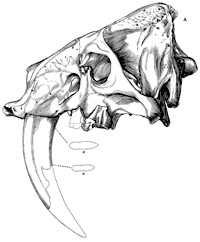Museum, University of Nebraska State

Bulletin of the University of Nebraska State Museum (1924–2023)
Date of this Version
2-1975
Document Type
Article
Citation
BULLETIN OF The University of Nebraska State Museum, VOLUME 10, NUMBER 1, PART 3, FEBRUARY, 1975, Pp. 35-46, Tables 1-3, Frontispiece, Figs. 1-5
Abstract
A new species of Pliocene peccary, Prosthennops (Macrogens) graffhami; is described from the Kimball Formation, Ogallala Group, Frontier County, Nebraska. This new species is the latest in geologic age and most advanced in the genus.
The remains of fossil vertebrates are generally rare in the upper part of the Ogallala group, and some have maintained that Hemphillian faunas such as Coffee Ranch and Smith County, Kansas, represent the latest Ogallala faunas. Later faunas than are typically considered as Hemphillian, containing more advanced forms, occur in the Kimball Formation and deposits of equivalent age. Known faunas which may be close to Kimballian are rare outside of Nebraska, although part of the Rattlesnake fauna in Oregon, the Axtel fauna in Texas, and the Guymon fauna in Oklahoma contain forms only somewhat more primitive than forms considered to be early Kimballian in age. The fauna of the lower part of the Kimball Formation in Nebraska is rapidly becoming the best known Pliocene fauna from North America, if the Blancan faunas are considered to be Early Pleistocene in age. Much Kimballian fauna has been recovered from U.N.S.M. Coil. Loc. Ft-40 (= Amebelodon fricki Locality). (See Schultz, Schultz, and Martin, 1970, for discussion of the faunal and stratigraphic position.)
Peccaries are relatively common in Ogallala faunas, although few good skulls have been described. This is especially unfortunate because the teeth tend to be conservative while the skulls are often highly modified (Colbert, 1938, p. 263). At least two distinct lineages of peccaries occur in the Ogallala Pliocene of the Central Great Plains. One of these, which includes Prosthennops (Macrogens), has large, triangular malar tuberosities, while the other lineage, Prosthennops (Prosthennops), lacks this feature. The new peccary described in this paper is the latest and most advanced known species of Prosthennops (Macrogens).
Included in
Entomology Commons, Geology Commons, Geomorphology Commons, Other Ecology and Evolutionary Biology Commons, Paleobiology Commons, Paleontology Commons, Sedimentology Commons


Comments
Copyright (c) 1975 University of Nebraska